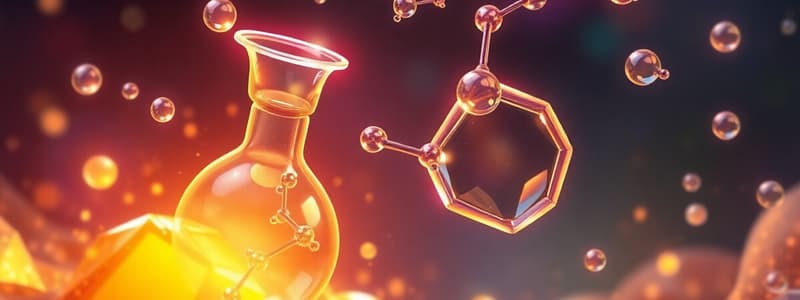Podcast
Questions and Answers
What type of chemical reaction is the conversion of an alcohol and a carboxylic acid into an ester and water?
What type of chemical reaction is the conversion of an alcohol and a carboxylic acid into an ester and water?
- Esterification (correct)
- Saponification
- Halogenation
- Hydrolysis
Which of the following is a necessary component for esterification to occur?
Which of the following is a necessary component for esterification to occur?
- Acid catalyst (correct)
- Inert atmosphere
- Reducing agent
- Strong base
What are the products when an ester reacts with water in a hydrolysis reaction?
What are the products when an ester reacts with water in a hydrolysis reaction?
- Carboxylic acid and base
- Alcohol and carboxylic acid (correct)
- Carbon dioxide and water
- Alcohol and acid catalyst
If methanol reacts with ethanoic acid, what ester is produced?
If methanol reacts with ethanoic acid, what ester is produced?
What is the general formula for an ester?
What is the general formula for an ester?
What properties are most associated with esters?
What properties are most associated with esters?
Which compounds are triglycerides formed from?
Which compounds are triglycerides formed from?
During the formation of a triglyceride from glycerol and fatty acids, how many water molecules are released?
During the formation of a triglyceride from glycerol and fatty acids, how many water molecules are released?
If a fatty acid is described as monounsaturated, what does this mean about its structure?
If a fatty acid is described as monounsaturated, what does this mean about its structure?
What structural feature differentiates a polyunsaturated fatty acid from a monounsaturated fatty acid?
What structural feature differentiates a polyunsaturated fatty acid from a monounsaturated fatty acid?
Which type of unsaturated fatty acid is more abundant in vegetable oils, nuts, and seeds?
Which type of unsaturated fatty acid is more abundant in vegetable oils, nuts, and seeds?
What process is used to convert liquid vegetable oils into solid or semi-solid fats?
What process is used to convert liquid vegetable oils into solid or semi-solid fats?
In terms of health benefits, which type of unsaturated fatty acids are generally considered more beneficial?
In terms of health benefits, which type of unsaturated fatty acids are generally considered more beneficial?
Where are trans fats most commonly found?
Where are trans fats most commonly found?
What is the purpose of adding hydrogen to liquid vegetable oils?
What is the purpose of adding hydrogen to liquid vegetable oils?
Which of the following best describes the structure of glycerol?
Which of the following best describes the structure of glycerol?
If pentanol reacts with butanoic acid, what ester is produced?
If pentanol reacts with butanoic acid, what ester is produced?
Which of the following is NOT a common use of esters?
Which of the following is NOT a common use of esters?
How many ester bonds are formed when glycerol reacts with three fatty acids to form a triglyceride?
How many ester bonds are formed when glycerol reacts with three fatty acids to form a triglyceride?
Which of the following best describes the relationship between esterification and hydrolysis?
Which of the following best describes the relationship between esterification and hydrolysis?
Flashcards
Ester Formation
Ester Formation
The reaction between an alcohol and a carboxylic acid to produce an ester and water.
Hydrolysis of Ester
Hydrolysis of Ester
The reverse process where an ester reacts with water to produce an alcohol and a carboxylic acid.
Acid catalyst
Acid catalyst
A substance that speeds up a chemical reaction without being consumed; often sulphuric acid in esterification.
Properties of Esters
Properties of Esters
Signup and view all the flashcards
Triglycerides
Triglycerides
Signup and view all the flashcards
Triglyceride Formation
Triglyceride Formation
Signup and view all the flashcards
Unsaturated Fatty Acids
Unsaturated Fatty Acids
Signup and view all the flashcards
Monounsaturated Fatty Acid
Monounsaturated Fatty Acid
Signup and view all the flashcards
Polyunsaturated Fatty Acid
Polyunsaturated Fatty Acid
Signup and view all the flashcards
Cis Unsaturated Fatty Acids
Cis Unsaturated Fatty Acids
Signup and view all the flashcards
Trans Unsaturated Fatty Acids
Trans Unsaturated Fatty Acids
Signup and view all the flashcards
Natural Sources of cis-
Natural Sources of cis-
Signup and view all the flashcards
Formation of Trans Fats
Formation of Trans Fats
Signup and view all the flashcards
Formation of methyl ethanoate
Formation of methyl ethanoate
Signup and view all the flashcards
Study Notes
Esters
- Esters are produced when an alcohol reacts with a carboxylic acid.
- The reaction between an alcohol and a carboxylic acid produces an ester and water.
- This process is reversible.
- An acid catalyst is needed, usually sulphuric acid.
- Alcohol + carboxylic acid → ester + water is esterification.
- Ester + water → alcohol + carboxylic acid is hydrolysis.
- General formula for esters is R-COO-R.
- Esters have a pleasant, fruity smell.
- Esters are volatile.
- Uses of esters include flavorings, fragrances, and solvents.
Naming Esters
- The naming of esters involves the alcohol and carboxylic acid from which they are derived.
- Alcohol + Carboxylic Acid -> Ester + Water
- Methanol + Ethanoic Acid → methyl ethanoate + water.
- Ethanol + Propanoic Acid → ethyl propanoate + water.
- Pentanol + Butanoic Acid → pentyl butanoate + water.
Triglycerides
- Triglycerides, including fats and oils, are esters.
- Glycerol + 3 fatty acids → triglyceride + 3 H2O.
- Alcohol + carboxylic acids → ester + water.
- Glycerol contains 3 hydroxyl groups which form 3 ester bonds.
- This process also produces 3 H2O molecules.
- Fatty acids contain double C=C bonds.
- Monounsaturated fatty acids contain 1 C=C bond.
- Polyunsaturated fatty acids contain > 1 C=C bond.
C=C Bonds Types
- Two types of C=C bonds: cis and trans.
Cis Isomers
- Abundant in nature.
- Found in vegetable oils, nuts, and seeds.
- More healthy.
Trans Isomers
- Found mostly in industrially processed foods.
- Also found in meat and dairy products.
- Artificial trans fats (ATFs) are created by adding hydrogen to liquid vegetable oils to solidify them (hydrogenation).
Studying That Suits You
Use AI to generate personalized quizzes and flashcards to suit your learning preferences.




